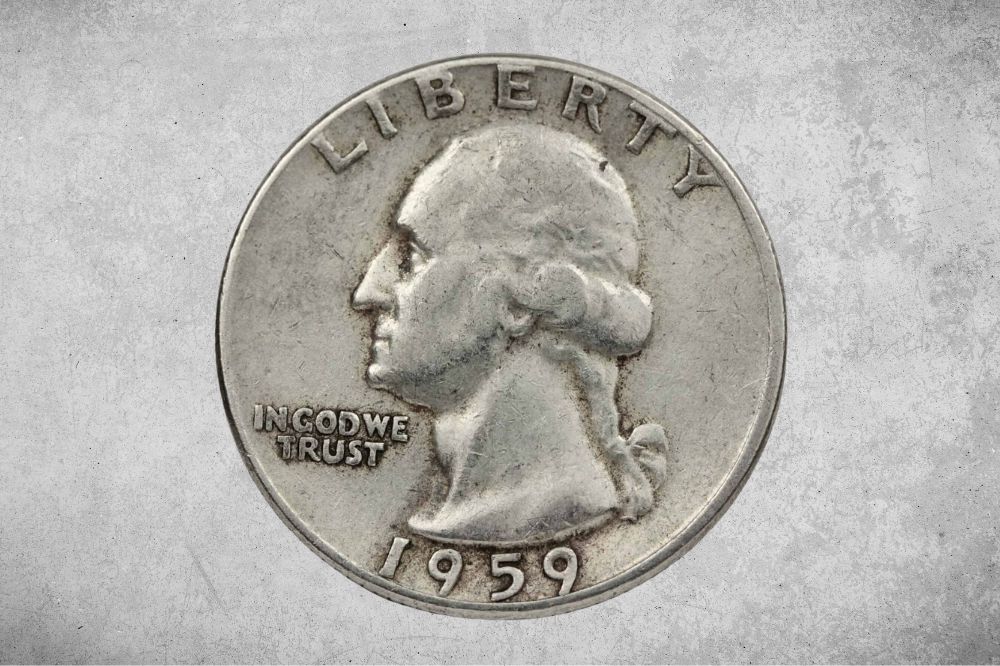Dig into the art of coin collecting and unravel the value of each coin in the current market. Coin collecting is definitely one of the most unique hobbies that can be both educational and satisfying. Since you are collecting coins, this can also be a lucrative challenge, hence the need to be knowledgeable of the basics.
So, in this guide, you will learn more about the 1959 Quarter value and all its key features, including the physical features, varieties, and even common errors. Likewise, we will expound on the history of this specific coin, along with some basic FAQs for easy reference.
1959 Quarter Details
- Category: Washington Quarter
- Mintage: Philadelphia and Denver
- Total mintage: 87,587,523
- Obverse designer: John Flanagan
- Reverse designer: John Flanagan
- Edge: Reeded
- Diameter: 24.3mm
- Thickness: 0.06889 inches
- Composition: Silver and copper
- Weight: 6.25 grams
- ASW: 0.1808oz
The 1959 Quarter is a 25-cent piece that is made of 90% silver and 10% copper. The coin weighs 6.25 grams with an actual silver weight of 0.1808oz. The edge of the coin is generally reeded, with a thickness of around 0.06889 inches.
As part of the Washington quarter series that began in 1932, this coin has the profile of the first US president, George Washington. The designer of the coin, John Flanagan, was a distinguished sculptor who was known for his statuaries, plaquettes, and commemorative medals.
The obverse section features the side profile of Washington, with the markings “LIBERTY’ just above the head and “IN GOD WE TRUST” on the left part. These particular words are widely acknowledged in the US mint and even by the American culture in general. You can also see the year 1959 in the lower area.
On the reverse side, the image of the American bald eagle is ingrained. If you look closely, the eagle is settled on a wreath of arrows, which characterizes the strength and the readiness of the country to go to war if times of emergency. Below the arrows are olive branches that depict peace.
At the lower part of the coin, you’d find the words “QUARTER DOLLAR.” Other carvings include the “E PLURIBUS UNUM” and “UNITED STATES OF AMERICA.” Although the original design was significantly acknowledged, there were changes in the reverse elements during 1998.
The total mintage of the 1959 Quarter coins was 87,587,523. Most of these were coins produced in Denver, with 62,054,232 pieces to be exact. Meanwhile, there were 24,384,000 no-mint mark coins and 1,149,291 proof coins minted in Philadelphia.
With over 85 years in circulation, the 1959 Quarter is dubbed one of the most remarkable US coins. In fact, it’s part of the longest-running coin series that is still widely used up to the present time. Accordingly, it’s very popular among dealers and collectors.
Another reason for its popularity is because of its silver composition, which largely impacts its value. Therefore, these coins are very much captivating for anyone who’d love to incorporate silver coins into their collection.
1959 Quarter Value Chart |
||||
| Mint Mark | Extremely Fine | MS60 | MS65 | PR63 |
| 1959 Quarter | $6.1 | $8.2 | $29 | $12 |
| 1959 D Quarter | $6.1 | $8.2 | $29 | / |
1959 Quarter Value and Varieties
Since the 1959 Quarter coin encompasses at least 90% silver, its value is relatively associated with the current value of silver. According to experts, the worth of a 1959 Quarter in good to excellent condition is around $6.1. Uncirculated ones may even reach up to $20.
Meanwhile, since this coin is mainly made of silver, it also comes with a melting value of around $4.16. And although there are two different minting locations, the value between the two does not differ by a mile.
In reality, these are the same, with only a major difference in the coin type―standard and proof ones. Proof coins have a certain price range. Likewise, the condition of the coin affects its valuation of the coins.
To better grasp the two main varieties of the 1959 Quarter―the 1959 Quarter with no mint and the 1958 D quarter―here’s a detailed summary that you should read thoroughly.
1959 Quarter
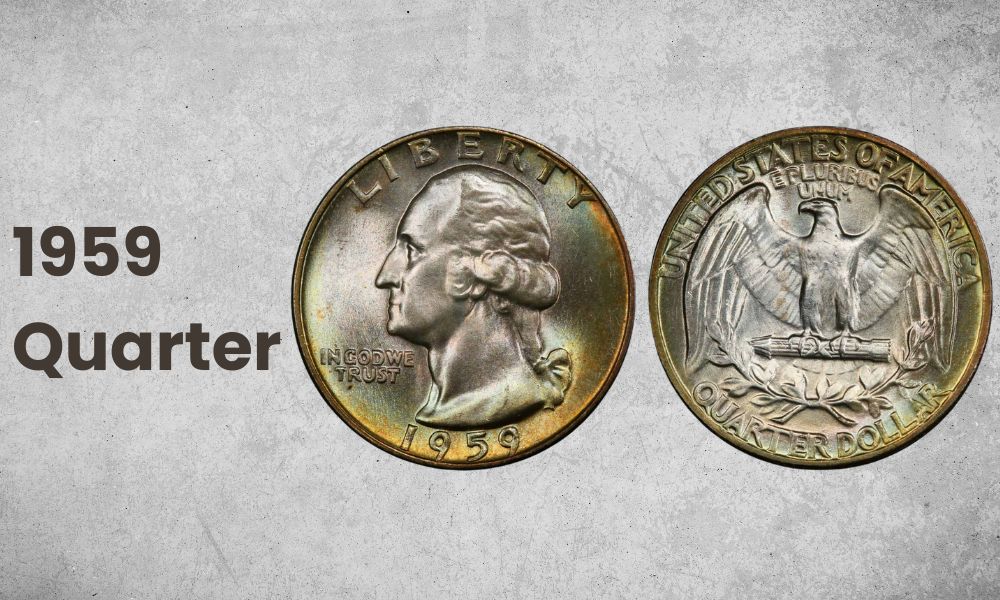
- Type: Washington Quarter
- Edge: Reeded
- Mint mark: None
- Place of minting: Philadelphia
- Year of minting:1959
- Face value:$0.25
- $ price:$6.1 to $29
- Quantity produced: 24,384,000
- Designer: John Flanagan
Just like most coins that are minted in Philadelphia, you won’t see a mint mark on a standard 1959 Quarter. There were at least 24 million pieces produced of this kind, mostly in good to extra fine condition. Higher grades like MS65, however, may be a challenge to find because of their limitation.
On top of the 1959 Quarter no mint mark, there were 1,149,291 proof ones. This is one of the main reasons why there’s only limited production in Philadelphia compared to Denver. The Philadelphia Mint created both business strike as well as proof strike coins.
Proof coins, in particular, are the most in-demand among collectors because of the intricacy of the design details. More so, these are shinier compared to the standard ones, highlighting the engraved elements of the coin. Because of its key features, proof coins are manually cleaned to ensure their condition and luster.
These unique features were created because proof coins are technically uncirculated coins, which means these were minted for collectors only. Thus, the value of uncirculated and proof coins is higher compared to the standard ones. Many would pay extra to get a hold of exceptional coins that are well-preserved.
1959 D Quarter
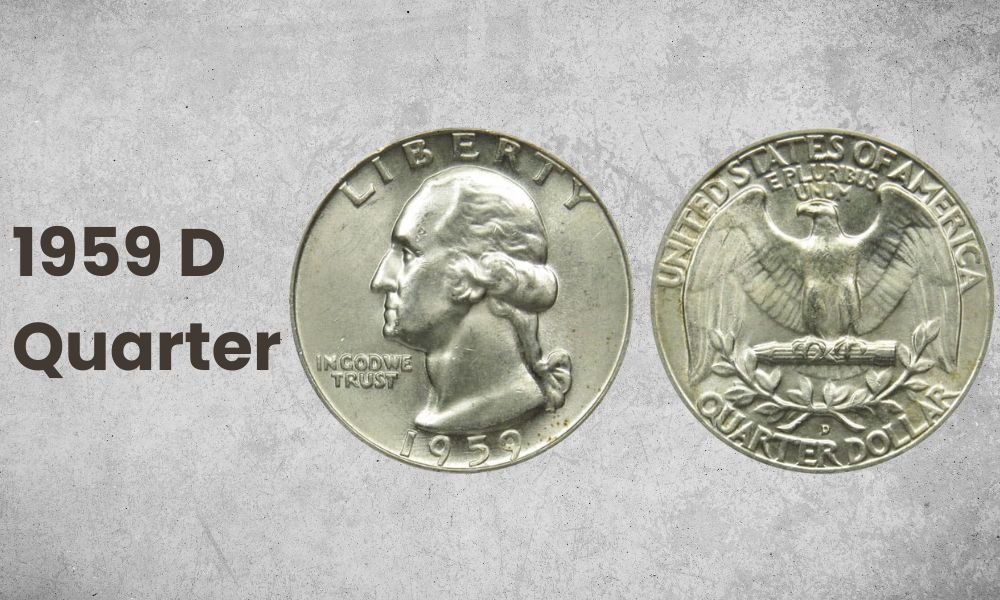
- Type: Washington Quarter
- Edge: Reeded
- Mint mark: None
- Place of minting: Denver
- Year of minting:1959
- Face value:$0.25
- $ price:$6.1 to $29
- Quantity produced: 62,054,232
- Designer: John Flanagan
On contrary, the 1959 D Quarter coins are those specifically minted in Denver. It’s very easy to distinguish these coins because of the letter “D” on the reverse side of the coin positioned just below the wreath of arrows and olive branches.
Impressively, over 62 million pieces of 1959 D Quarter coins were produced, which is more than twice the amount minted in Philadelphia. Moreover, there weren’t proof coins created in Denver.
Although the valuation of Denver and Philadelphia coins typically differ from one another, this coin mintage is one of the few instances when the selling prices are the same. So, if you have a 1959 D Quarter coin, you can expect that this would be priced between $6.1 and $29.
Also Read: 10+ Rarest State Quarter Errors Lists (Worth Much Money!!!)
1959 Quarter History
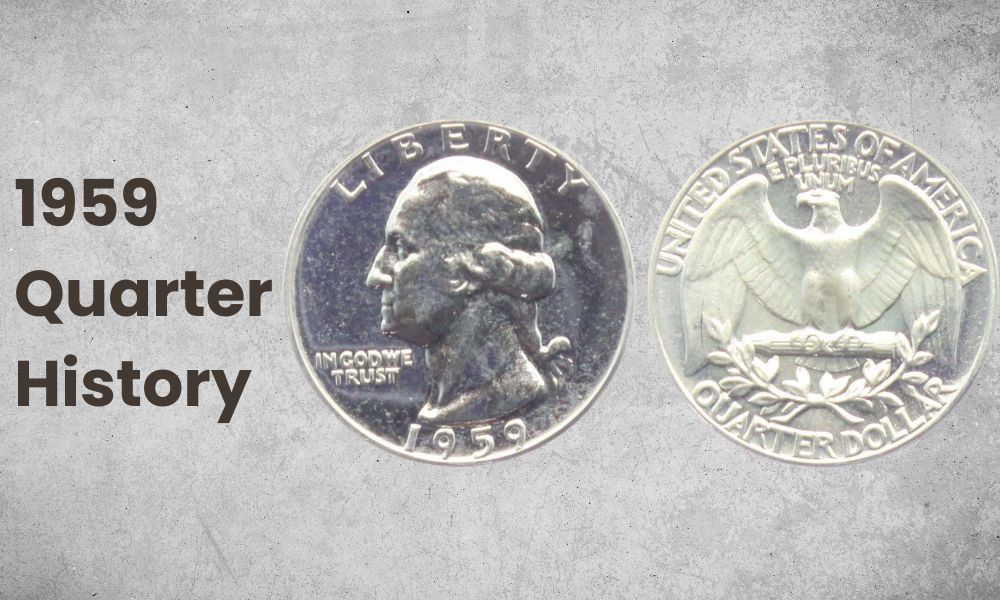
The Washington Quarter coin series started in 1932, though the Quarter dollar has been minted on and off since the 17th century. During this time, the US Mint publicized the need for a new design that should encompass the image of the first US president, George Washington.
Although Laura Gardin Fraser won the competition, the US Treasure opted for the design created by John Flanagan. From then, the first production of the Quarter coin began during the outburst of World War II. It then continued up to the early days of the Vietnam War.
Because of its historical background, no wonder why many collectors are fascinated to get a hold of these coins. Over the years, obtaining these noteworthy pieces have become more challenging, especially coins in excellent condition and those that were produced from 1932 until 1964.
It’s because during this period, the Washington Quarter was significantly made of silver, 90% to be exact. This means that the 1959 Quarter is part of the Washington Quarter series that has a relevant amount of silver content.
After 1964, the US Mint switched the composition of Quarter coins into a combination of copper and nickel. With no silver content, this resulted in a slight decline in value for Washington quarters. But even with the modifications, the Washington Quarter continues to be a charm for dealers and collectors.
During 1959 production, there were two minting locations―Philadelphia and Denver. The city of Philadelphia has always been one of the largest producers of coins in the country. And for the 1959 Quarter, they created both standard and proof coins for a total of 25,533,291.
On the other hand, Denver also took part in the production of the Quarter coins, creating over 62 million struck quarter coins. That year, the city held the biggest number of Washington quarters, all of which are standard ones.
Also Read: Top 15 Most Valuable Quarters In Circulation
1959 Quarter Grading
The grading of the 1959 Quarter is highly dependent on the grading of the coin, whether it’s in good condition or it’s considered in mint state. Since there isn’t much difference in value between Philadelphia and Denver 1959 pieces, the major basis would be the state as well as the type of the coin.
Also Read: Top 16 Most Valuable Modern Quarters Worth Money
1959 Quarter Error
Featuring over 87 million pieces, errors were quite inevitable during the production of the 1959 Quarter. This is particularly evident for the coins struck in Denver, with at least 62 million coins in circulation. So, let’s discuss some of the rarities and errors for your guidance.
1. 1959 Quarter Double Die
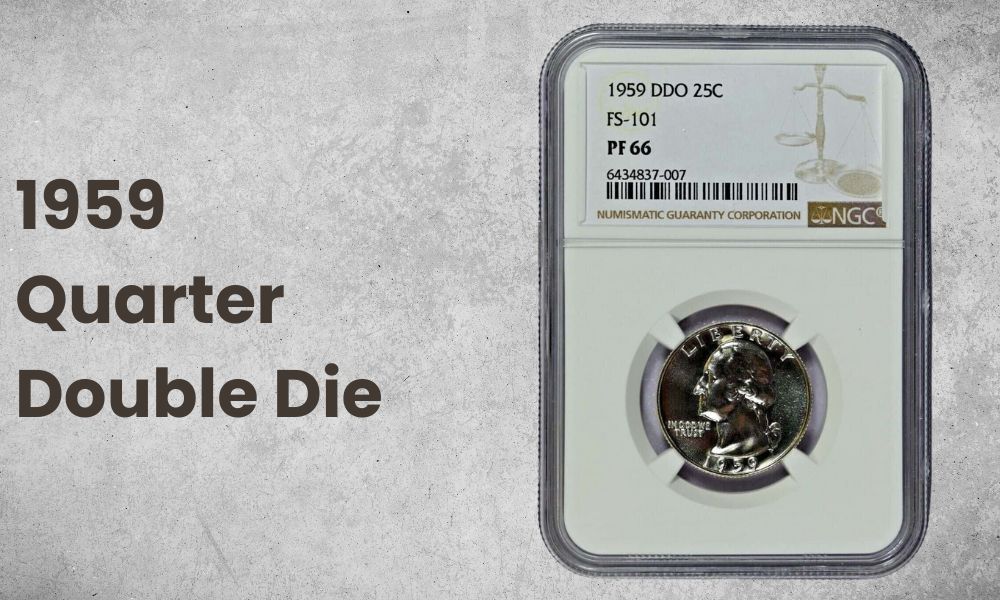
One of the most common issues during the minting of the 1959 Quarter was double-die. This error is a result of misalignment of the die, hence the need to double strike to imprint the elements. And there were several 1959 quarters with double die circulated in the market.
Although errors generally affect the value of the coins, there are some collectors who would pay more for these unique pieces. It’s because they believe these are more distinct compared to the standard ones, adding up to their rarity.
2. 1959 Quarter Struck-through
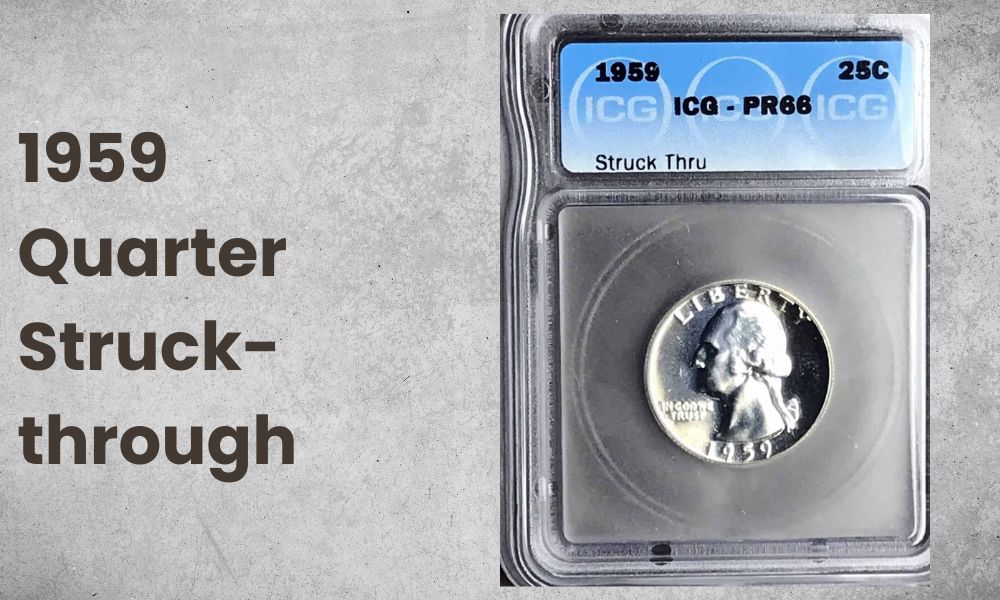
On the other hand, there were coins produced in 1959 that have struck-through issues. These were pieces that have unnecessary marks on the surface, and the reason was due to a struck-through error. The flaw on the planchet occurred because of a foreign material that hampered the minting process.
These could be external resources like dust and metal scraps. Grease could also cause a struck-through problem on the coins. Some collectors, however, are interested to buy these rare coins for a high price. But of course, this may vary accordingly, depending on the location and the preferences.
3. 1959 Quarter Off-strike
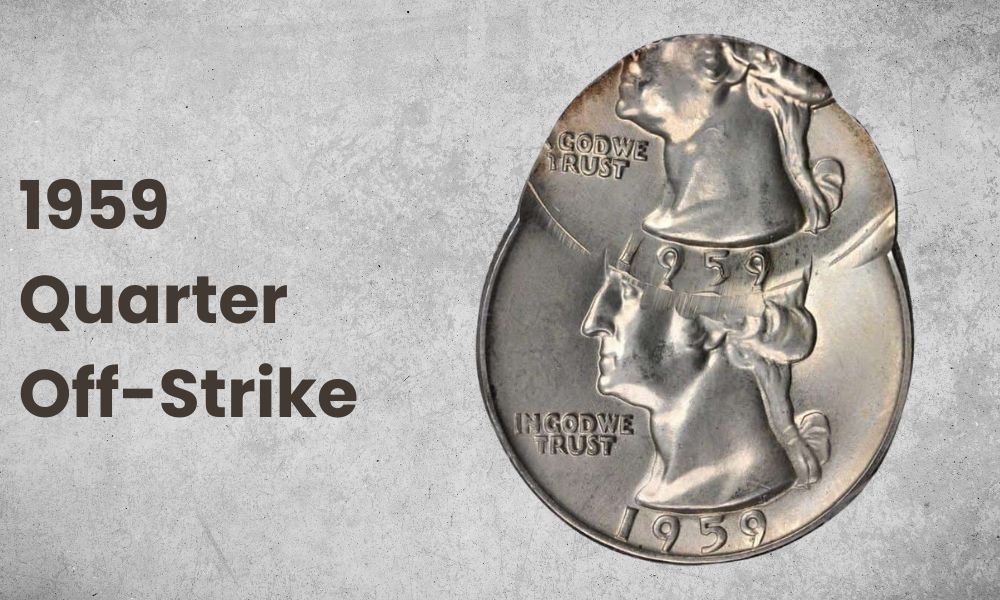
There were instances when the die struck the planchet of 1959 Quarter coins at an incorrect angle. As a result, there’s an off-strike error or misalignment of the design on either the obverse or reverse side of the coin. Off-strike coins are commonly still accepted, but only for a certain percentage.
Often than not, experts and dealers only acknowledged off-strikes within the 40% to 60% angle from the center. If not, there would be a significant decrease in the value of the coins.
4. 1959 Quarter Broadstrike
Another problem with the 1959 Quarter was some broad strike issues that were caused by improper setting up of the planchet during the process. Consequently, the surface of the coin does not contain a collar, which then affects the diameter of the coin.
This leads to the expansion of the coin boundary. The typical look of a coin with a broad strike error is like that of a pancake with no retaining collar. And of course, these errors also impact the coin’s worth, either positively or negatively.
1959 Quarter FAQ
1. How much is a 1959 quarter worth?
The estimated worth of a standard 1959 quarter in good to extra fine condition settles around $6.1 whereas an MS65 grade may be valued up to $29. These values are applicable to both Philadelphia and Denver-minted coins. Meanwhile, proof ones are worth at least $20.
2. Is the 1959 US quarter silver?
With a content of 90% silver, the 1959 quarter is one of the limited Washington Quarter coin editions that were made out of silver and copper. Because of the silver content, this made the 1959 Quarter and Washington quarter coins produced from 1932 to 1964 popular among collectors.
After 1964, there was a massive change in the materials used for Washington Quarter. From silver copper, the coins were now produced out of copper and nickel.
3. Where is the mint mark on the 1959 quarter?
There are actually two mint locations for the 1959 Quarter―in Philadelphia and in Denver. Coins produced in Philadelphia do not have any mint marks. However, those that were minted in Denver have the letter “D” on the reverse side of the coin, specifically below the wreath.
